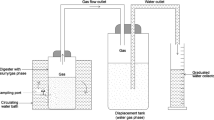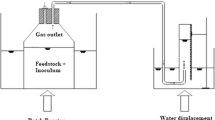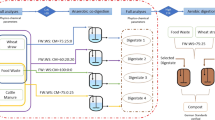Abstract
This study investigated the influence of seasonal variation of fruits, vegetables and agrowastes (FVA) generated in wholesale markets in New Delhi, India, for biogas production. The mechanically pretreated FVA wastes were individually co-digested with waste activated sludge (WAS) under mesophilic conditions for 30 d. The combination of radish leaves with WAS exhibited the highest biogas yield of 407.22 mL/g VSfed. Later, four different mixed combinations were formulated based on four different seasons (pre-monsoon, monsoon, post-monsoon and winter) to digest using three different inocula: waste activated sludge (WAS), cow dung and anaerobic sludge. The mixed combination of substrates for the winter season co-digested with WAS provided the highest biogas yield of 699.49 mL/g VSfed. The modified Gompertz model predicted the biogas potential from all the experimental results and simulated that the lignocellulosic substrates exhibited high lag time (> 1). The biodegradability index (BD) was lower (< 50%) for all the individual substrates, other than the case of reactor with radish leaves and WAS. Most of the mixed substrate’s combination exhibited BD above 50% and also showed positive synergistic effects of 1.25 to 1.94, most probably due to the positive attributes of co-digestion strategy. With the future prospects available to improve the digestibility of certain substrates, a thermogravimetric analysis was conducted on them. It suggests that the thermal degradation of each substrate varies according to its individual characteristics. Hence, possibilities of strategizing thermal pretreatment for selected substrates could be further evaluated, delivering improved sustainable energy utilization and enhanced biogas production.




Similar content being viewed by others
Data availability
The data will be made available on request.
References
Antwi E, Engler N, Nelles M, Schüch A (2019) Anaerobic digestion and the effect of hydrothermal pretreatment on the biogas yield of cocoa pods residues. Waste Manag 88:131–140. https://doi.org/10.1016/j.wasman.2019.03.034
APHA (1995) Standard Methods for the Examination of Water and Wastewater vol.21; American Public Health Association: Washington, DC, USA.
Arhoun B, Villen-Guzman M, Gomez-Lahoz C, Rodriguez-Maroto JM, Garcia-Herruzo F, Vereda-Alonso C (2019) Anaerobic co-digestion of mixed sewage sludge and fruits and vegetable wholesale market waste: composition and seasonality effect. J Water Process Eng 31:100848. https://doi.org/10.1016/j.jwpe.2019.100848
ASTM E1755-01 (2020) Standard test method for ash in biomass. American Society for Testing and Materials, New York, NY.
ASTM E871-82 (2019) Standard test method for moisture analysis of particulate wood fuels. American Society of Testing Materials, New York, NY.
ASTM E872-82 (2019) Standard test method for volatile matter in the analysis of particulate wood fuels. American Society for Testing and Materials, New York, NY.
Azadpur Produce Market Committee (2019) Retrieved from: http://www.apmcazadpurdelhi.com/aboutus.pdf
Baghel P, Sakhiya AK, Kaushal P (2022) Influence of temperature on slow pyrolysis of Prosopis Juliflora: an experimental and thermodynamic approach. Renew Energy 185:538–551. https://doi.org/10.1016/j.renene.2021.12.053
Bhuvaneshwari S, Hettiarachchi H, Meegoda JN (2019) Crop residue burning in India: policy challenges and potential solutions. Int J Environ Res Public Health 16:832. https://doi.org/10.3390/ijerph16050832
Che Kamarludin SN, Jainal MS, Azizan A, Safaai NSM, Mohamad Daud AR (2014) Mechanical pretreatment of lignocellulosic biomass for biofuel production. Appl Mech Mater 625:838–841. https://doi.org/10.4028/www.scientific.net/AMM.625.838
D’Silva TC, Isha A, Chandra R, Vijay VK, Subbarao PMV, Kumar R et al (2021) Enhancing methane production in anaerobic digestion through hydrogen assisted pathways–a state-of-the-art review. Renew Sustain Energy Rev 151:111536. https://doi.org/10.1016/j.rser.2021.111536
D’Silva TC, Verma S, Magdaline RM, Chandra R, Khan AA (2022a) Environmental resilience and sustainability through green technologies: a case evidence from rural coastal India. Environ Eng Res 27(5):1–11. https://doi.org/10.4491/eer.2021.262
D’Silva TC, Isha A, Verma S, Shirsath G, Chandra R, Vijay VK, Subbarao PMV, Kovács KL (2022b) Anaerobic co-digestion of dry fallen leaves, fruit/vegetable wastes and cow dung without an active inoculum–a biomethane potential study. Bioresour Technol Rep 19:101189. https://doi.org/10.1016/j.biteb.2022.101189
Datta R (1981) Acidogenic fermentation of lignocellulose–acid yield and conversion of components. Biotechnol Bioeng 23:2167–2170. https://doi.org/10.1002/bit.260230921
Devi S, Gupta C, Jat SL, Parmar MS (2017) Crop residue recycling for economic and environmental sustainability: the case of India. Open Agric 2:486–494. https://doi.org/10.1515/opag-2017-0053
Di Girolamo G, Grigatti L, Barbanti L, Angelidaki I (2013) Effects of hydrothermal pre-treatments on Giant reed (Arundo donax) methane yield. Bioresour Technol 147:152–159. https://doi.org/10.1016/j.biortech.2013.08.006
Du J, Qian Y, Xi Y, Lü X (2019) Hydrothermal and alkaline thermal pretreatment at mild temperature in solid state for physicochemical properties and biogas production from anaerobic digestion of rice straw. Renew Energy 139:261–267. https://doi.org/10.1016/j.renene.2019.01.097
Elliott A, Mahmood T (2012) Comparison of mechanical pretreatment methods for the enhancement of anaerobic digestion of pulp and paper waste activated sludge. Water Environ Res 84:497–505. https://doi.org/10.2175/106143012X13347678384602
FAOSTAT (2018) Retrieved from: http://www.fao.org/faostat/en/#data/QC/visualize
Gandhi BP, Otite SV, Fofie EA, Lag-Brotons AJ, Ezemonye LI, Semple KT, Martin AD (2022) Kinetic investigations into the effect of inoculum to substrate ratio on batch anaerobic digestion of simulated food waste. Renew Energy 195:311–321. https://doi.org/10.1016/j.renene.2022.05.134
Gaur RZ, Khan AA, Suthar S (2017) Effect of thermal pre-treatment on co-digestion of duckweed (Lemna gibba) and waste activated sludge on biogas production. Chemosphere 174:754–763. https://doi.org/10.1016/j.chemosphere.2017.01.133
Ghosh P, Kumar M, Kapoor R, Kumar SS, Singh L, Vijay V, Vijay VK, Kumar V, Thakur IS (2020) Enhanced biogas production from municipal solid waste via co-digestion with sewage sludge and metabolic pathway analysis. Bioresour Technol 296:122275. https://doi.org/10.1016/j.biortech.2019.122275
Herrmann AP, Willems M, Janke HD (2001) Degradation of natural polyphenols by methanogenic consortia enriched from digested municipal sludge. Water Res 35(11):2575–2582. https://doi.org/10.1016/S0043-1354(00)00574-1
Horticultural Statistics 2018 Retrieved from: http://agricoop.nic.in/sites/default/files/Horticulture%20Statistics%20at%20a%20Glance-2018.pdf
Hou T, Zhao J, Lei Z, Shimizu K, Zhang Z (2020) Synergistic effects of rice straw and rice bran on enhanced methane production and process stability of anaerobic digestion of food waste. Bioresour Technol 314:123775. https://doi.org/10.1016/j.biortech.2020.123775
Isha A, Kumar S, Jha B, Subbarao PMV, Chandra R, Vijay VK (2020) Development of stabilization methods using a pilot scale anaerobic digester for seasonal variations in kitchen wastes for improved methane production with zero breakdowns. Clean Eng Technol 1:100015. https://doi.org/10.1016/j.clet.2020.100015
Isha A, D’Silva TC, Subbarao PMV, Chandra R, Vijay VK (2021) Stabilization of anaerobic digestion of kitchen wastes using protein-rich additives: study of process performance, kinetic modelling and energy balance. Bioresour Technol 337:125331. https://doi.org/10.1016/j.biortech.2021.125331
Jena SP, Mishra S, Acharya SK, Mishra SK (2017) An experimental approach to produce biogas from semi dried banana leaves. Sustain Energy Technol Assess 19:173–178. https://doi.org/10.1016/j.seta.2017.01.001
Jha B, Chandra R, Vijay VK, Subbarao PMV, Isha A (2020) Utilization of de-oiled rice bran as a feedstock for renewable biomethane production. Biomass Bioenergy 140:105674. https://doi.org/10.1016/j.biombioe.2020.105674
Joshi R, Ahmed S (2016) Status and challenges of municipal solid waste management in India: a review. Cogent Environ Sci 2:1139434. https://doi.org/10.1080/23311843.2016.1139434
Kafle GK, Kim SH (2013) Anaerobic treatment of apple waste with swine manure for biogas production: batch and continuous operation. Appl Energy 103:61–72. https://doi.org/10.1016/j.apenergy.2012.10.018
Kang X, Zhang Y, Song B, Sun Y, Li L, He Y, Kong X, Luo X, Yuan Z (2019) The effect of mechanical pretreatment on the anaerobic digestion of hybrid Pennisetum. Fuel 252:469–474. https://doi.org/10.1016/j.fuel.2019.04.134
Kapoor R, Subbarao PMV, Vijay VK, Shah G, Sahota S, Singh D, Verma M (2017) Factors affecting methane loss from a water scrubbing based biogas upgrading system. Appl Energy 208:1379–1388. https://doi.org/10.1016/j.apenergy.2017.09.017
Karthikeyan OP, Trably E, Mehariya S, Bernet N, Wong JW, Carrere H (2018) Pretreatment of food waste for methane and hydrogen recovery: a review. Bioresour Technol 249:1025–1039. https://doi.org/10.1016/j.biortech.2017.09.105
Khan SA, D’Silva TC, Kumar S, Chandra R, Vijay VK, Misra A (2021) Mutually trading off biochar and biogas sectors for broadening biomethane applications: A comprehensive review. J Clean Prod 318: 128593. https://doi.org/10.1016/j.jclepro.2021.128593
Kim J, Kim J (2019) Lee C (2019) Anaerobic co-digestion of food waste, human feces, and toilet paper: Methane potential and synergistic effect. Fuel 248:189–195. https://doi.org/10.1016/j.fuel.2019.03.081
Kumari K, Suresh S, Arisutha S, Sudhakar K (2018) Anaerobic co-digestion of different wastes in a UASB reactor. Waste Manag 77:545–554. https://doi.org/10.1016/j.wasman.2018.05.007
Li X, Li L, Zheng M, Fu G (2009) Lar JS (2009) Anaerobic co-digestion of cattle manure with corn stover pretreated by sodium hydroxide for efficient biogas production. Energy Fuels 23:4635–4639. https://doi.org/10.1021/ef900384p
Lowe TB, Hatch BT, Antle C, Nartker S, Ammerman ML (2020) One-and two-stage anaerobic co-digestion of cucumber waste and sewage sludge. Environ Technol 41:3157–3165. https://doi.org/10.1080/09593330.2019.1601262
Ma X, Jiang T, Chang J, Tang Q, Luo T, Cui Z (2019) Effect of substrate to inoculum ratio on biogas production and microbial community during hemi-solid-state batch anaerobic co-digestion of rape straw and dairy manure. Appl Biochem Biotechnol 189:884–902. https://doi.org/10.1007/s12010-019-03035-9
Mao C, Zhang T, Wang X, Feng Y, Ren G, Yang G (2017) Process performance and methane production optimizing of anaerobic co-digestion of swine manure and corn straw. Sci Report 7:9379. https://doi.org/10.1038/s41598-017-09977-6
Nah IW, Kang YW, Hwang KY, Song WK (2000) Mechanical pretreatment of waste activated sludge for anaerobic digestion process. Water Res 34:2362–2368. https://doi.org/10.1016/S0043-1354(99)00361-9
Negi S, Dhar H, Hussain A, Kumar S (2018) Biomethanation potential for co-digestion of municipal solid waste and rice straw: A batch study. Bioresour Technol 254:139–144. https://doi.org/10.1016/j.biortech.2018.01.070
Neves L, Oliveira R, Alves MM (2004) Influence of inoculum activity on the bio-methanization of a kitchen waste under different waste/inoculum ratios. Process Biochem 39:2019–2024. https://doi.org/10.1016/j.procbio.2003.10.002
Nirmal NP, Khanashyam AC, Mundanat AS, Shah K, Babu KS, Thorakkattu P et al (2023) Valorization of fruit waste for bioactive compounds and their applications in the food industry. Foods 12(3):556. https://doi.org/10.3390/foods12030556
Odetoye TE, Afolabi TJ, Abu Bakar MS et al (2018) Thermochemical characterization of Nigerian Jatropha curcas fruit and seed residues for biofuel production. Energ Ecol Environ 3:330–337. https://doi.org/10.1007/s40974-018-0104-0
Qiao W, Yan X, Ye J, Sun Y, Wang W, Zhang Z (2011) Evaluation of biogas production from different biomass wastes with/without hydrothermal pretreatment. Renew Energy 36:3313–3318. https://doi.org/10.1016/j.renene.2011.05.002
Rajput AA, Visvanathan C (2018) Effect of thermal pretreatment on chemical composition, physical structure and biogas production kinetics of wheat straw. J Environ Manag 221:45–52. https://doi.org/10.1016/j.jenvman.2018.05.011
Sawyerr N, Trois C, Workneh T (2019) Identification and characterization of potential feedstock for biogas production in South Africa. J Ecol Eng 2019:20. https://doi.org/10.12911/22998993/108652
Subbarao PMV, D’Silva TC, Adlak K, Kumar S, Chandra R, Vijay VK (2023) Anaerobic digestion as a sustainable technology for efficiently utilizing biomass in the context of carbon neutrality and circular economy. Environ Res 234:116286. https://doi.org/10.1016/j.envres.2023.116286
Tyagi VK, Fdez-Güelfo LA, Zhou Y, Álvarez-Gallego CJ, Garcia LR, Ng WJ (2018) Anaerobic co-digestion of organic fraction of municipal solid waste (OFMSW): progress and challenges. Renew Sustain Energy Rev 93:380–399. https://doi.org/10.1016/j.rser.2018.05.051
Vaish B, Srivastava V, Singh P et al (2016) Exploring untapped energy potential of urban solid waste. Energ Ecol Environ 1:323–342. https://doi.org/10.1007/s40974-016-0023-x
Vats N, Khan AA, Ahmad K (2019a) Anaerobic co-digestion of thermal pre-treated sugarcane bagasse using poultry waste. J Environ Chem Eng 7:103323. https://doi.org/10.1016/j.jece.2019.103323
Vats N, Khan AA, Ahmad K (2019b) Observation of biogas production by sugarcane bagasse and food waste in different composition combinations. Energy 185:1100–1105. https://doi.org/10.1016/j.energy.2019.07.080
VDI 4630 (2006) (2018) Fermentation of organic materials, characterisation of the substrates, sampling, collection of material data, fermentation test. VDI-Handbuch Energietechnik.
Veeken A, Hamelers B (1999) Effect of temperature on hydrolysis rates of selected biowaste components. Bioresour Technol 69:249–254. https://doi.org/10.1016/S0960-8524(98)00188-6
Velmurugan B, Ramanujam RA (2011) Anaerobic digestion of vegetable wastes for biogas production in a fed-batch reactor. Int J Emerg Sci 1:478
Wang X, Li Z, Bai X, Zhou X, Cheng S, Gao R, Sun J (2018) Study on improving anaerobic co-digestion of cow manure and corn straw by fruit and vegetable waste: methane production and microbial community in CSTR process. Bioresour Technol 249:290–297. https://doi.org/10.1016/j.biortech.2017.10.038
Ward AJ, Hobbs PJ, Holliman PJ, Jones DL (2018) Optimization of the anaerobic digestion of agricultural resources. Bioresour Technol 99:7928–7940. https://doi.org/10.1016/j.biortech.2008.02.044
Yang H, Yan R, Chen H, Lee DH, Zheng C (2007) Characteristics of hemicellulose, cellulose and lignin pyrolysis. Fuel 86:1781–1788. https://doi.org/10.1016/j.fuel.2006.12.013
Yi J, Dong B, Jin J, Dai X (2014) Effect of increasing total solids contents on anaerobic digestion of food waste under mesophilic conditions: performance and microbial characteristics analysis. PLoS ONE 9:e102548. https://doi.org/10.1371/journal.pone.0102548
Yoon YM, Kim SH, Shin KS, Kim CH (2014) Effects of substrate to inoculum ratio on the biochemical methane potential of piggery slaughterhouse wastes. Asian Australas J Animal Sci 27:600. https://doi.org/10.5713/ajas.2013.13537
Acknowledgements
The authors are highly grateful to the Science and Engineering Research Board (SERB), Government of India, vide grant no. ECR/2016/000296 for providing financial assistance to carry out this study.
Author information
Authors and Affiliations
Corresponding author
Ethics declarations
Conflict of interest
The authors declare that they have no known competing financial interests or personal relationships that could have appeared to influence the work reported in this paper.
Supplementary Information
Below is the link to the electronic supplementary material.
Rights and permissions
Springer Nature or its licensor (e.g. a society or other partner) holds exclusive rights to this article under a publishing agreement with the author(s) or other rightsholder(s); author self-archiving of the accepted manuscript version of this article is solely governed by the terms of such publishing agreement and applicable law.
About this article
Cite this article
Hasan, B., D’Silva, T.C., Gaur, R.Z. et al. Evaluating biogas potential of organic fraction of wholesale market wastes in New Delhi, India: anaerobic co-digestion with sewage sludge and cattle manure. Energ. Ecol. Environ. (2023). https://doi.org/10.1007/s40974-023-00310-8
Received:
Revised:
Accepted:
Published:
DOI: https://doi.org/10.1007/s40974-023-00310-8




